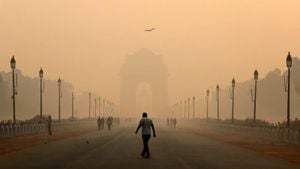The long-standing tensions between Israel and Hezbollah have erupted once again, digging deep roots back to the violent upheavals of the past and reshaping the geopolitical framework of the Middle East. The conflict escalated dramatically after Hezbollah's Secretary-General, Hassan Nasrallah, announced on October 8, 2023, the group’s commitment to assist Hamas amid its own intense clashes with Israel. Acknowledging Hezbollah as a “support front,” he aimed to divert Israeli military focus and resources from one front to the next, stirring fears of broader hostilities across the region.
This shift wasn't merely theoretical but marked the launch of what would become months of relentless aggression. For Israel, the situation spiraled out of control on July 27, 2023, when the tragic loss of life—12 Druze teenagers killed by a Hezbollah rocket—compelled the nation to reevaluate its military strategy. A drastic change of tactics emerged, leading to September 2024 when Israeli forces initiated widespread, aggressive military operations along its northern borders.
The ensuing Israeli military campaign was not just about retaliation; it transformed perceptions of warfare from something contained within strict rules of engagement to full-blown assault. Israel's strategy tore four decades of restraint, unleashing airstrikes and ground operations intended to dismantle Hezbollah's command structure and infrastructure. The results of this unrestrained military action were staggering—significant casualties were reported among Hezbollah's ranks, including the deaths of Nasrallah and various leading commanders.
Devastation crossed and culminated across the Lebanese valley, leading to the obliteration of entire villages, as around 29 Lebanese settlements faced destruction. Innocent lives painted the front lines as over 1.5 million people, predominantly from southern Lebanon, were subjected to brutal displacements. Many fled their homes, seeking refuge within the enclaves of sympathetic communities like Christians and Druze, causing underlying tensions to amplify, raising alarms of potential sectarian conflicts.
The socio-political fabric of Lebanon is fraying as the repercussions of Israel's military incursion ripple through the streets. The geopolitical shifts speak volumes as 400,000 Syrian refugees have gone back across the border, and approximately 150,000 Lebanese citizens have also made their way to Syria and Iraq, driven by desperation rather than safety.
The Lebanese citizens' sentiments toward Nasrallah and Hezbollah are mixed. While some voicing their discontent claim Hezbollah tied Lebanon to its latest debacle, others—especially within the Shiite community—find themselves standing steadfast with the organization, rooting for its survival. The call for aid backdrops the conflict: desperation echoes through the hearts of civilians trying to piece together what remains of their homes and lives.
Turning to the politics of the Christian community within Lebanon deepens the inquiry. Since October 2022, Christians have witnessed significant losses, including the vacant presidential role, due to resistance from factions like Hezbollah and Amal, who prefer candidates aligned with their interests, such as Suleiman Franjieh. The central issue of electing this head orchestrates through sectarian lines, raising fears of chaos as it intertwines with current military engagements.
Adding insult to injury, the post of the governor of the Bank of Lebanon is also vacant following the arrest of its former governor, Riad Salameh. The impending retirement of Army Chief Joseph Aoun, another Christian figure, poses additional worries, leaving the succession open to mistrust and potential strife. Will Aoun's successor be one whom these community members can trust?
While people are weary, they continue to cling to old agreements like the Taif Accords of 1990, which helped quell the Lebanese civil war. Nevertheless, as ancient leadership roles shift and fade, calls for new accords resound. The legitimacy of how Lebanon's governing framework evolved no longer fits the remnants of what exists today. How will this impact the future governing power dynamics within Lebanon's complex political psychology?
Geagea's declaration to the parliament, voicing the need to convene members sans the 26 Shia MPs boycotting, provoked outrage, heightening fears of the Lebanese body politic's disintegration. This sentiment didn’t stop there; Druze leader Walid Jumblatt voiced concerns about Hezbollah's leadership vacuum following the loss of its key figure, Nasrallah, questioning the organization's direction amid existential threats.
The international community is questioning the future of Yemen too, amid calls for action from the Maronite archbishop seeking to reopen discussions on those historic agreements. The pressing question becomes one of survival: With Hezbollah embedded increasingly within the popular fabric, can Lebanon navigate these treacherous waters, and what are the prospects for peace?
Israel's latest military operations triggered backlash, forcing Western powers, including the United States, to temper their support. US policy has reacted not only to these developments but has become embroiled and increasingly cautious about the real human cost of continued Israeli aggression. This shift has been marked by growing calls for accountability, highlighting the stark humanitarian crisis building within Gaza, where over 90 Palestinians were reported dead from recent airstrikes.
Back on the ground, the fabric of life continues to unravel as heated exchanges between Israel, Hezbollah, and widespread civilian challenges reveal the depth of suffering felt. Ground forces are deploying increasingly sophisticated military strategies, yet as they do, questions of future engagement linger, coupled with pressing humanitarian needs. How many more casualties will be reported before this blanket of violence lifts? And can any of the entrenched parties truly claim victory?
Israel is now seen razing significant cultural and historical sites like the Shrine of Shimon located within the village of Chamaa, reported destroyed by mining operations during this fierce incursion. All too often, historical losses are compensated for by advancing military agendas, which only serve to deepen the scars—drawing ancient lines of conflict anew.
The international ramifications of these military strikes wield tremendous influence over Lebanon's future as it attempts to navigate through one of its country's toughest crises to date. The world watches as this crucible of conflict can spiral unfathomably outward, testing both regional and international responses to the festering wound of gunfire and despair. Pakistan’s whispers, Iran’s watchful interventions, and the shadow of foreign influence all contribute layers to the complex web of what remains.
This chapter of relentless conflict raises the universal question: how can equilibrium restore itself after such insurmountable loss and ever-deepening division? Lebanon stands at the crossroads of change, poised precariously between the weights of history, survival, and sovereignty. The outcomes here could reverberate across the Middle East, making room for either unprecedented reconciliation or the firmer solidification of longstanding divides. Recent gains must be watched carefully; only time will tell if they usher Lebanon back toward agency or amplify its current chaos.



